|
|
|
|
|
|
|
 |
 |
|
|
 |
|
|
 |
|
 |
|
|
 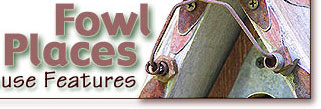 |
|
 |
|
|
|
 |
|
|
|
|
|
Fowl Places strives to construct the best possible nestboxes for birds from unique, previously used materials. The five Features categories listed above will link you to sections of this web page describing the characteristics found in each and every Fowl Places birdhouse.
 Selecting the small Fowl Places logo link will return you to the top of this web page. Selecting the small Fowl Places logo link will return you to the top of this web page.
|
|
|
|
|
|
|
|
 |
|
|
|
 |
|
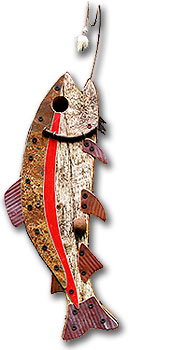 |
|
|
|
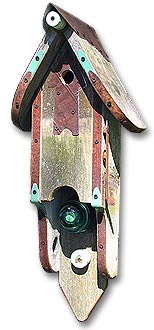 |
|
|
 |
|
 |
|
|
|
Opening Fowl Places birdhouses for cleaning and inspection requires no tools. Roll your mouse over these four birdhouses to see animations of their opening methods. In the Railroad, Jumping Trout and Trademark birdhouses the doors either rotate up or down to expose the entire nesting compartment. The right side of the Hanging Hutch slides down and can be completely removed from the birdhouse.
Below is a closeup sequence of a bolt keeper being rotated. The bolt and washer it keeps in place holds the door shut. The bolt is used only as a pin inserted in a hole that goes through the birdhouse side and into the door. Simply pull out the bolt then rotate the door to open. Each birdhouse product tag describes the opening sequence to use for that particular birdhouse.
|
|
|
|
|
|
|
|
 |
|
|
|
 |
|
|
|
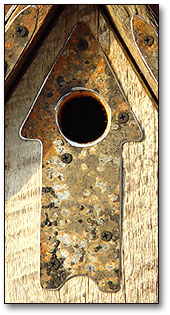 Two features are found on each Fowl Places birdhouse door - a metal face plate and an interior ladder. Two features are found on each Fowl Places birdhouse door - a metal face plate and an interior ladder.
The metal face plate helps ensure that the entry hole size remains the same as when purchased (entry hole diameter and interior compartment size are matched for particular bird species) . The face plate prohibits woodpeckers and various predators from enlarging the entry hole.
A ladder of sorts is used on the interior of the door to assist the exit of certain bird species from the birdhouse upon initial inspection. Tree Swallows and Violet-green Swallows may be able to enter some birdhouses and not get back out. Interior ladders prohibit this situation from occurring.
For complete guidelines on the proper construction of nestboxes for cavity nesting species please visit the North American Bluebird Society's website. |
|
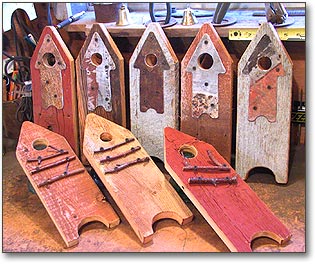
Please note that no perches are used on the front of Fowl Places birdhouses. Perches are not necessary. In fact, they offer an advantage to predators and non-native bird species (Starlings and House Sparrows). House Sparrows have been known to kill native species when establishing nest sites in birdhouses. |
|
|
|
|
|
|
 |
|
|
 |
|
|
|
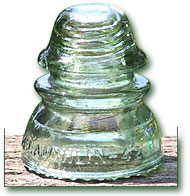 Fowl Places birdhouse designs often contain one or more old fence and/or utility pole insulators. The value of glass insulators range widely, from less than $1 up into the thousands of dollars. Fowl Places birdhouse designs often contain one or more old fence and/or utility pole insulators. The value of glass insulators range widely, from less than $1 up into the thousands of dollars.  For further information on insulators please visit the National Insulator Association's website and the Insulators Canada website. For further information on insulators please visit the National Insulator Association's website and the Insulators Canada website.
 |
|
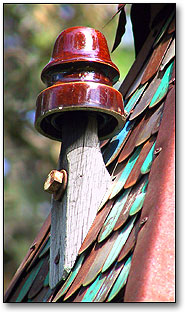
|
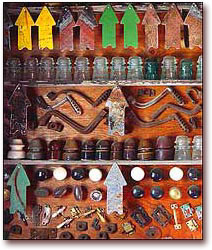
|
If it won't come off the bracket - the bracket is used. ;-)
|
|
|
|
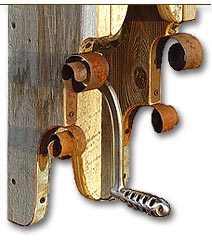 |
|
Old, rusty metal banding is used extensively. Often the banding is curled to achieve interesting shapes which compliment curved wood cuts. In the photo to the left individual metal tiles are often used on birdhouse roofs. These tiles are cut lengths of wider old metal banding. The coloration of these metal tiles is due to previously painted green and blue metal banding. Please note that Fowl Places uses no paints, stains, or other chemicals. All materials are used as obtained. Only cursory cleaning is done with mild dish washing soaps and water to remove dirt from metal, porcelain, and glass used in construction.
|
|
The photo to the right shows a sampling of cut out face plates, insulators, old door knobs, wood stove shakers, and other items on one of the walls inside the Fowl Places shop.
|
|
|
|
Pictured above is part of an old chicken and cattle barn roofed with narrowly corrugated metal sheeting. Both the wood and metal are used in making many Fowl Places birdhouses - including a few located at the property owners home near this site. This barn is located northeast of Green Bluff near Spokane, Washington - a popular local orchard, berry, and squash growing area. More of this barn can be seen in the photo at the bottom of the main page.
|
|
This picture shows a portion of the old Tonasket Aqueduct (Tonasket, Washington). It is a wooden structure lined with metal. The metal was originally tarred. Very little of this aqueduct system, built early in the 1900s by Chinese laborers, is left standing. Weathered metal sheeting from portions of the aqueduct which collapsed long ago is cut up to form face plates, roofing, trim and custom fittings on a majority of Fowl Places birdhouses. |
|
|
|
|
|
|
|
|
|
 |
|
|
|
 |
|
|
|
|
|
|
Only new screws are used as fasteners in construction. Except for the shortest of screws (3/4" roof and face plate screws) all screw holes are predrilled to prohibit wood splitting. If needed, a Fowl Places birdhouse may be completely disassembled for thorough cleaning or repair without damaging the birdhouse materials.
Protection from the elements begins at the top in Fowl Places birdhouses. All birdhouse roof ridges are covered by metal sheeting affixed to the wooden roofs. Metal ridge caps, ventilation gaps front and rear, and notched interior floors help keep nesting compartments as dry as possible.
|
|
|
|
|
|
|
|
|
|
 |
|
|
 |
|
|
|
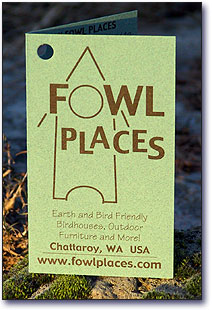 |
|
Fowl Places products are branded with the Fowl Places logo and have a product card attached. The product card lists the cavity nesting bird species for which the birdhouse is designed. It also contains information on the manufacturer and style of the glass insulator attached. All glass and porcelain insulators used by Fowl Places were made by Canadian or U.S. manufacturers no later than 20 or 30 years ago (these types of glass insulators are no longer being made in Canada or the U.S. - they are being replaced by newer porcelain designs).
Website design and photography by Fowl Places.
|
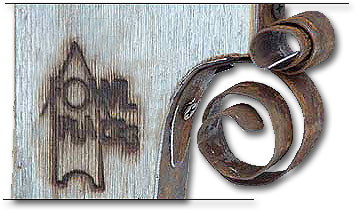 |
|
|
|
|
 |
 |
|
|
|
 |
 |
 |
 |
 |
 |
 |
 |
 |
 |
 |
|
|
|
|
 |
 |
 |
 |
 |
 |
   |
|
|
|
|
|
 |
 |
 |
 |
     |
|
|
|
|
|
|
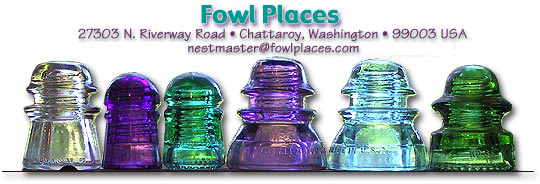 |
|
|
|
|
|
|
|
|
|
|
|
|
|
|
|
|
|
|
|
|
|
|
|
|
|
|
|
|
|
|
|
|
|
|
|
|
|
|
|
|
|
|
|
|
|
|
|
|
|
|
|
|
|
|
|
|
|
|
|
|
|
|
|
|
|
|
|
|